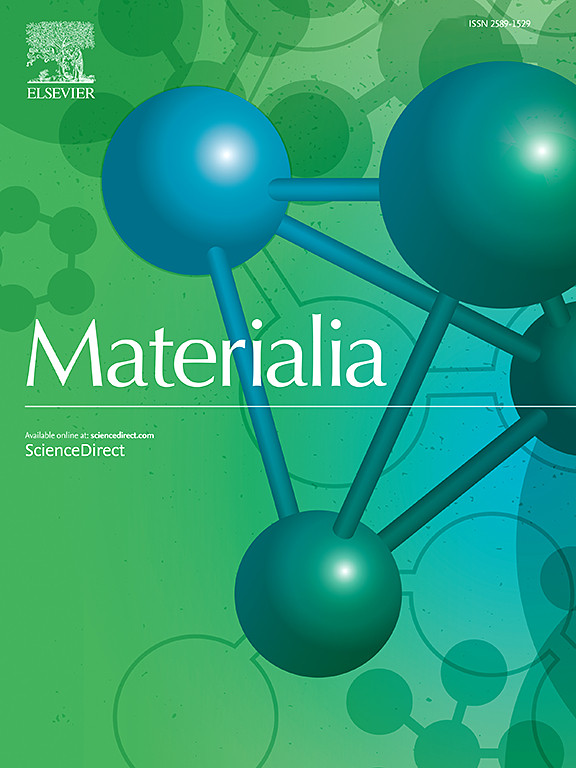大规模转变的新见解:原位x射线观察和TRIP钢中δ到γ转变的扩散界面分析
IF 3
Q2 MATERIALS SCIENCE, MULTIDISCIPLINARY
引用次数: 0
摘要
最近对碳钢凝固的原位研究表明,δ到γ的转变可以在高度过冷时发生,甚至在单一γ相区域,这种转变被研究人员称为块状或块状。在本研究中,使用集成了x射线成像、劳厄衍射和精确温度测量的装置,研究了两种实验用TRIP钢的δ到γ相变。比较了T1钢(0.1% C-1.23% Mn-1.97% Si)和T2钢(0.23% C-1.55% Mn-1.87% Si)的亚包晶合金。结果表明,两种钢的δ向γ转变均发生在γ单相区,但转变速率明显不同。与Mn和Si含量较低的碳钢相比,这些钢表现出行为上的差异,如结果部分所述。研究了δ - γ转变的热力学和界面动力学,以进一步了解这种转变行为。热力学分析表明,两种钢的转变强烈依赖于T0温度的过冷,而不是平衡包晶温度。采用弥散界面模型,分析了δ向γ转变的动力学过程。结果表明,界面速度与热力学驱动力之间存在两种不同的关系:一种是C、Mn和Si分划的低速区,另一种是Mn和Si几乎不分划的高速区。在这些钢中观察到的大量转变分别发生在低速和高速状态。本文章由计算机程序翻译,如有差异,请以英文原文为准。

New insights into massive transformation: In-situ X-ray observations and diffuse interface analysis of δ to γ transformation in TRIP steels
Recent in-situ studies on carbon steel solidification have shown that the δ to γ transformation can occur at a high degree of undercooling, even in the single γ-phase region, a transformation referred to as massive or massive-like by researchers. In this study, the δ to γ phase transformation of two experimental TRIP steels was investigated using a setup that integrates X-ray imaging, Laue diffraction, and precise temperature measurement. Steel T1, a hypo-peritectic alloy (0.1% C-1.23% Mn-1.97% Si), and Steel T2, a hyper-peritectic alloy (0.23% C-1.55% Mn-1.87% Si), were compared. The results reveal that the δ to γ transformation in both steels occurred within the single γ-phase region, but at significantly different rates. Compared to carbon steels with lower Mn and Si content, these steels exhibit differences in behavior, as discussed in the results section.
The thermodynamic and interface kinetic of the δ to γ transformation were investigated to gain deeper insights into this transformation behavior. Thermodynamic analysis reveals that the transformation in both steels is strongly dependent on undercooling from the temperature, rather than the equilibrium peritectic temperature. Using a diffuse interface model of massive transformation, the kinetics of the δ to γ transformation were analyzed. The results showed two distinct regimes in the relationship between interface velocity and thermodynamic driving force: a low-velocity regime with partitioning of C, Mn, and Si, and a high-velocity regime with almost no partitioning of Mn and Si. The massive transformations observed in these steels occurred in the low and high-velocity regimes, respectively.
求助全文
通过发布文献求助,成功后即可免费获取论文全文。
去求助
来源期刊

Materialia
MATERIALS SCIENCE, MULTIDISCIPLINARY-
CiteScore
6.40
自引率
2.90%
发文量
345
审稿时长
36 days
期刊介绍:
Materialia is a multidisciplinary journal of materials science and engineering that publishes original peer-reviewed research articles. Articles in Materialia advance the understanding of the relationship between processing, structure, property, and function of materials.
Materialia publishes full-length research articles, review articles, and letters (short communications). In addition to receiving direct submissions, Materialia also accepts transfers from Acta Materialia, Inc. partner journals. Materialia offers authors the choice to publish on an open access model (with author fee), or on a subscription model (with no author fee).
 求助内容:
求助内容: 应助结果提醒方式:
应助结果提醒方式:


